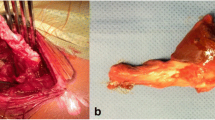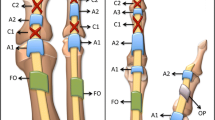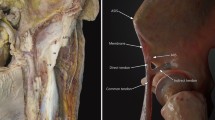Abstract
We describe the magnetic resonance (MR) imaging appearance of the knee flexor and extensor tendons after bilateral rectus femoris transfer and hamstring lengthening surgery in five patients (10 limbs) with cerebral palsy. Three-dimensional models of the path of the transferred tendon were constructed in all cases. MR images of the transferred and lengthened tendons were examined and compared with images from ten non-surgical subjects. The models showed that the path of the transferred rectus femoris tendon had a marked angular deviation near the transfer site in all cases. MR imaging demonstrated irregular areas of low signal intensity near the transferred rectus femoris and around the hamstrings in all subjects. Eight of the ten post-surgical limbs showed evidence of fluid near or around the transferred or lengthened tendons. This was not observed in the non-surgical subjects. Thus, MR imaging of patients with cerebral palsy after rectus femoris transfer and hamstring-lengthening surgery shows evidence of signal intensity and contour changes, even several years after surgery.





Similar content being viewed by others
References
Nene AV, Evans GA, Patrick JH. Simultaneous multiple operations for spastic diplegia. Outcome and functional assessment of walking in 18 patients. J Bone Joint Surg Br 1993; 75:488–494
Patrick JH. Techniques of psoas tenotomy and rectus femoris transfer: “new” operations for cerebral palsy diplegia—a description. J Pediatr Orthop B 1996; 5:242–246
Perry J. Distal rectus femoris transfer. Dev Med Child Neurol 1987; 29:153–158
Gage JR, Perry J, Hicks RR, Koop S, Werntz JR. Rectus femoris transfer to improve knee function of children with cerebral palsy. Dev Med Child Neurol 1987; 29:159–166
Asakawa D, Blemker S, Gold G, Delp SL. In vivo motion of the rectus femoris muscle after tendon transfer surgery. J Biomech 2002; 35:1029–1037
Riewald SA, Delp SL. The action of the rectus femoris muscle following distal tendon transfer: does it generate a knee flexion moment? Dev Med Child Neurol 1997; 39:99–105
Friden J, Albrecht D, Lieber RL. Biomechanical analysis of the brachioradialis as a donor in tendon transfer. Clin Orthop Rel Res 2001:152–161
Strickland JW. Development of flexor tendon surgery: twenty-five years of progress. J Hand Surg 2000; 25:214–235
Arnold AS, Salinas S, Asakawa DJ, Delp SL. Accuracy of muscle moment arms estimated from MRI-based musculoskeletal models of the lower extremity. Comput Aided Surg 2000; 5:108–119
Bencardino JT, Rosenberg ZS, Brown RR, Hassankhani A, Lustrin ES, Beltran J. Traumatic musculotendinous injuries of the knee: diagnosis with MR imaging. Radiographics 2000; 20:S103–S120
El-Khoury GY, Brandser EA, Kathol MH, Tearse DS, Callaghan JJ. Imaging of muscle injuries. Skeletal Radiol 1996; 25:3–11
May DA, Disler DG, Jones EA, Balkissoon AA, Manaster BJ. Abnormal signal intensity in skeletal muscle at MR imaging: patterns, pearls, and pitfalls. Radiographics 2000; 20:S295–S315
Drape JL, Silbermann-Hoffman O, Houvet P, et al. Complications of flexor tendon repair in the hand: MR imaging assessment. Radiology 1996; 198:219–224
Jamali AA, Afshar P, Abrahms RA, Lieber RL. Skeletal muscle response to tenotomy. Muscle Nerve 2000; 23:851–862
Dhawilkar SH, Root L, Mann RL. Distal lengthening of the hamstrings in patients who have cerebral palsy. J Bone Joint Surg 1992; 74A:1385–1391
Eriksson K, Kindblom LG, Hamberg P, Larsson H, Wredmark T. The semitendinosus tendon regenerates after resection: a morphologic and MRI analysis in 6 patients after resection for anterior cruciate ligament reconstruction. Acta Orthop Scand 2001; 72:379–384
Acknowledgements
We gratefully acknowledge the Rehabilitation Research and Development Service and the VA Palo Alto Health Care System, the National Institutes of Health (grants HD38962, T32 GM63495), the Motion Analysis Lab at Shriners Hospitals for Children Northern California, the Whitaker Foundation, and graduate fellowships from the National Science Foundation, the Whitaker Foundation, and the American Association of University Women.
Author information
Authors and Affiliations
Corresponding author
Additional information
This work was presented at the ISS Special Scientific Session 2002, Geneva
Rights and permissions
About this article
Cite this article
Gold, G.E., Asakawa, D.S., Blemker, S.S. et al. Magnetic resonance imaging findings after rectus femoris transfer surgery. Skeletal Radiol 33, 34–40 (2004). https://doi.org/10.1007/s00256-003-0702-5
Received:
Revised:
Accepted:
Published:
Issue Date:
DOI: https://doi.org/10.1007/s00256-003-0702-5




